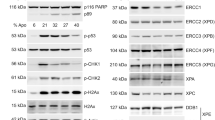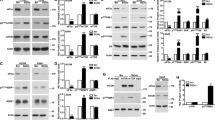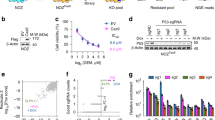Abstract
Translational control at the initiation step has been recognized as a major and important regulatory mechanism of gene expression. Eukaryotic initiation factor-3a (eIF3a), a putative subunit of the eIF3 complex, has recently been shown to have an important role in regulating the translation of a subset of mRNAs and is found to correlate with the prognosis of cancers. In this study, using nasopharyngeal carcinoma (NPC) cells as a model system, we tested the hypothesis that eIF3a negatively regulates the synthesis of nucleotide excision repair (NER) proteins, and, in turn, cellular response to treatments with DNA-damaging agents such as cisplatin (cis-dichlorodiammine platinum(II) (CDDP)). We found that a CDDP-sensitive sub-clone S16 isolated through limited dilution from an NPC cell line CNE-2 has increased eIF3a expression. Knocking down its expression in S16 cells increased cellular resistance to CDDP, NER activity and synthesis of the NER proteins XPA, XPC, RAD23B and RPA32. Altering eIF3a expression also changed the cellular response to CDDP and UV treatment in other NPC cell lines. Taken together, we conclude that eIF3a has an important role in the CDDP response and in NER activity of NPCs by suppressing the synthesis of NER proteins.
This is a preview of subscription content, access via your institution
Access options
Subscribe to this journal
Receive 50 print issues and online access
$259.00 per year
only $5.18 per issue
Buy this article
- Purchase on Springer Link
- Instant access to full article PDF
Prices may be subject to local taxes which are calculated during checkout






Similar content being viewed by others
References
Afqir S, Ismaili N, Errihani H . (2009). Concurrent chemoradiotherapy in the management of advanced nasopharyngeal carcinoma: current status. J Cancer Res Ther 5: 3–7.
Agulnik M, Siu LL . (2005). State-of-the-art management of nasopharyngeal carcinoma: current and future directions. Br J Cancer 92: 799–806.
Bachmann F, Banziger R, Burger MM . (1997). Cloning of a novel protein overexpressed in human mammary carcinoma. Cancer Res 57: 988–994.
Baujat B, Audry H, Bourhis J, Chan AT, Onat H, Chua DT et al. (2006). Chemotherapy in locally advanced nasopharyngeal carcinoma: an individual patient data meta-analysis of eight randomized trials and 1753 patients. Int J Radiat Oncol Biol Phys 64: 47–56.
Chaudhuri J, Chakrabarti A, Maitra U . (1997). Biochemical characterization of mammalian translation initiation factor 3 (eIF3). Molecular cloning reveals that p110 subunit is the mammalian homologue of Saccharomyces cerevisiae protein Prt1. J Biol Chem 272: 30975–30983.
Chen G, Burger MM . (1999). p150 expression and its prognostic value in squamous-cell carcinoma of the esophagus. Int J Cancer 84: 95–100.
Chen G, Burger MM . (2004). p150 overexpression in gastric carcinoma: the association with p53, apoptosis and cell proliferation. Int J Cancer 112: 393–398.
Dellas A, Torhorst J, Bachmann F, Banziger R, Schultheiss E, Burger MM . (1998). Expression of p150 in cervical neoplasia and its potential value in predicting survival. Cancer 83: 1376–1383.
Dong Z, Liu LH, Han B, Pincheira R, Zhang JT . (2004). Role of eIF3 p170 in controlling synthesis of ribonucleotide reductase M2 and cell growth. Oncogene 23: 3790–3801.
Dong Z, Liu Y, Zhang JT . (2005). Regulation of ribonucleotide reductase M2 expression by the upstream AUGs. Nucleic Acids Res 33: 2715–2725.
Dong Z, Liu Z, Cui P, Pincheira R, Yang Y, Liu J et al. (2009). Role of eIF3a in regulating cell cycle progression. Exp Cell Res 315: 1889–1894.
Dong Z, Zhang JT . (2003). EIF3 p170, a mediator of mimosine effect on protein synthesis and cell cycle progression. Mol Biol Cell 14: 3942–3951.
Dong Z, Zhang JT . (2006). Initiation factor eIF3 and regulation of mRNA translation, cell growth, and cancer. Crit Rev Oncol Hematol 59: 169–180.
Friedberg EC . (2001). How nucleotide excision repair protects against cancer. Nat Rev Cancer 1: 22–33.
Furuta T, Ueda T, Aune G, Sarasin A, Kraemer KH, Pommier Y . (2002). Transcription-coupled nucleotide excision repair as a determinant of cisplatin sensitivity of human cells. Cancer Res 62: 4899–4902.
Koo HM, Gray-Goodrich M, Kohlhagen G, McWilliams MJ, Jeffers M, Vaigro-Wolff A et al. (1999). The ras oncogene-mediated sensitization of human cells to topoisomerase II inhibitor-induced apoptosis. J Natl Cancer Inst 91: 236–244.
Li Z, Dong Z, Myer D, Yip-Schneider M, Liu J, Cui P et al. (2010). Role of 14-3-3sigma in poor prognosis and in radiation and drug resistance of human pancreatic cancers. BMC Cancer 10: 598.
Liu H, Liu Y, Zhang JT . (2008). A new mechanism of drug resistance in breast cancer cells: fatty acid synthase overexpression-mediated palmitate overproduction. Mol Cancer Ther 7: 263–270.
Liu Y, Liu H, Han B, Zhang JT . (2006). Identification of 14-3-3sigma as a contributor to drug resistance in human breast cancer cells using functional proteomic analysis. Cancer Res 66: 3248–3255.
Mathews MB, Sonenberg N, Hershey JWB . (2000). Origins and principles of translational control. In: Sonenberg N, Hershey JWB and Mathews MB (eds). Translational Control of Gene Expression. Cold Spring Harbor Laboratory Press: New York, pp 1–32.
Neher TM, Rechkunova NI, Lavrik OI, Turchi JJ . (2010a). Photo-cross-linking of XPC–Rad23B to cisplatin-damaged DNA reveals contacts with both strands of the DNA duplex and spans the DNA adduct. Biochemistry 49: 669–678.
Neher TM, Shuck SC, Liu JY, Zhang JT, Turchi JJ . (2010b). Identification of novel small molecule inhibitors of the XPA protein using in silico based screening. ACS Chem Biol 5: 953–965.
Nouspikel T . (2009). DNA repair in mammalian cells: nucleotide excision repair: variations on versatility. Cell Mol Life Sci 66: 994–1009.
Oldroyd NJ, Urquhart AJ, Kimpton CP, Millican ES, Watson SK, Downes T et al. (1995). A highly discriminating octoplex short tandem repeat polymerase chain reaction system suitable for human individual identification. Electrophoresis 16: 334–337.
Pincheira R, Chen Q, Zhang JT . (2001). Identification of a 170-kDa protein overexpressed in lung cancers. Br J Cancer 84: 1520–1527.
Qian CN, Berghuis B, Tsarfaty G, Bruch M, Kort EJ, Ditlev J et al. (2006). Preparing the ‘soil’: the primary tumor induces vasculature reorganization in the sentinel lymph node before the arrival of metastatic cancer cells. Cancer Res 66: 10365–10376.
Qiao Y, Spitz MR, Guo Z, Hadeyati M, Grossman L, Kraemer KH et al. (2002). Rapid assessment of repair of ultraviolet DNA damage with a modified host-cell reactivation assay using a luciferase reporter gene and correlation with polymorphisms of DNA repair genes in normal human lymphocytes. Mutat Res 509: 165–174.
Sancar A, Lindsey-Boltz LA, Unsal-Kacmaz K, Linn S . (2004). Molecular mechanisms of mammalian DNA repair and the DNA damage checkpoints. Annu Rev Biochem 73: 39–85.
Siddik ZH . (2003). Cisplatin: mode of cytotoxic action and molecular basis of resistance. Oncogene 22: 7265–7279.
Thephamongkhol K, Zhou J, Browman G, Wong R, Chan J, Zeng Y et al. (2004). Chemoradiotherapy versus radiotherapy alone for nasopharyngeal carcinoma: a meta-analysis of 78 randomized controlled trials (RCTs) from English and non-English databases. J Clin Oncol 22: 493s.
Wang H, Vardy LA, Tan CP, Loo JM, Guo K, Li J et al. (2010). PCBP1 suppresses the translation of metastasis-associated PRL-3 phosphatase. Cancer Cell 18: 52–62.
Xiao WW, Han F, Lu TX, Chen CY, Huang Y, Zhao C . (2009). Treatment outcomes after radiotherapy alone for patients with early-stage nasopharyngeal carcinoma. Int J Radiat Oncol Biol Phys 74: 1070–1076.
Xu J, Peng H, Chen Q, Liu Y, Dong Z, Zhang JT . (2007). Oligomerization domain of the multidrug resistance-associated transporter ABCG2 and its dominant inhibitory activity. Cancer Res 67: 4373–4381.
Yang Y, Chen Q, Zhang JT . (2002). Structural and functional consequences of mutating cysteine residues in the amino terminus of human multidrug resistance-associated protein 1. J Biol Chem 277: 44268–44277.
Yang Y, Liu Y, Dong Z, Xu J, Peng H, Liu Z et al. (2007). Regulation of function by dimerization through the amino-terminal membrane-spanning domain of human ABCC1/MRP1. J Biol Chem 282: 8821–8830.
Yin JY, Dong Z, Liu ZQ, Zhang JT . (2011a). Translational control gone awry: a new mechanism of tumorigenesis and novel targets of cancer treatments. Biosci Rep 31: 1–15.
Yin JY, Shen J, Dong Z, Huang Q, Zhong MZ, Feng DY et al. (2011b). Effect of eIF3a on response of lung cancer patients to platinum-based chemotherapy by regulating DNA repair. Clinical Cancer Res (in press).
Zhang L, Pan X, Hershey JW . (2007). Individual overexpression of five subunits of human translation initiation factor eIF3 promotes malignant transformation of immortal fibroblast cells. J Biol Chem 282: 5790–5800.
Zou Y, Liu Y, Wu X, Shell SM . (2006). Functions of human replication protein A (RPA): from DNA replication to DNA damage and stress responses. J Cell Physiol 208: 267–273.
Acknowledgements
The CDDP-sensitive clone S16 was established and characterized at Van Andel Research Institute. The stable CNE-2 cells with eIF3a overexpression and the SUNE-1 cell line were studied at Sun Yat-sen University Cancer Center. All other studies were performed at the Indiana University School of Medicine. The VARI team dedicate this paper to the memory of a friend and co-worker, Dr Han-Mo Koo. This work was supported in part by the National Institutes of Health Grant CA94961 (JTZ), the Showalter Trust Fund (ZD) and the National Natural Science Foundation of China (no. 81071822) (RYL).
Author information
Authors and Affiliations
Corresponding author
Ethics declarations
Competing interests
The authors declare no conflict of interest.
Additional information
Supplementary Information accompanies the paper on the Oncogene website
Supplementary information
Rights and permissions
About this article
Cite this article
Liu, RY., Dong, Z., Liu, J. et al. Role of eIF3a in regulating cisplatin sensitivity and in translational control of nucleotide excision repair of nasopharyngeal carcinoma. Oncogene 30, 4814–4823 (2011). https://doi.org/10.1038/onc.2011.189
Received:
Revised:
Accepted:
Published:
Issue Date:
DOI: https://doi.org/10.1038/onc.2011.189
Keywords
This article is cited by
-
eIF3a regulation of mTOR signaling and translational control via HuR in cellular response to DNA damage
Oncogene (2022)
-
A highly annotated database of genes associated with platinum resistance in cancer
Oncogene (2021)
-
Oroxylin A reverses hypoxia-induced cisplatin resistance through inhibiting HIF-1α mediated XPC transcription
Oncogene (2020)
-
Molecular characterization and integrative genomic analysis of a panel of newly established penile cancer cell lines
Cell Death & Disease (2018)
-
Exploring the key genes and signaling transduction pathways related to the survival time of glioblastoma multiforme patients by a novel survival analysis model
BMC Genomics (2017)



